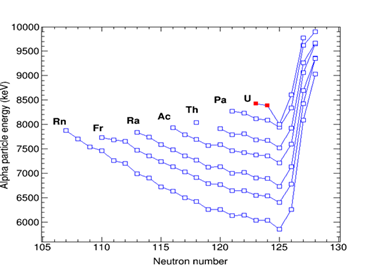Researchers at Institute of Modern Physics (IMP), Chinese Academy of Sciences have observed two new neutron-deficient isotopes 216U and 215U on the gas-filled recoil separator, SHANS (Spectrometer for Heavy Atoms and Nuclear Structure).
The discovery of new isotopes is the first necessary step to explore and understand new nuclei. Overall about 3200 different nuclides have been discovered so far (2014), most of them are synthesized in the laboratory beyond the 339 naturally occurring nuclides. Neutron-deficient isotopes closed to the proton drip line are always produced in the complete-fusion reactions and they are identified on the basis of time-position-energy correlated α-decay chains. Twenty–five uranium isotope from A=215 to 242 have been discovered so far with 220,221U and 241U yet to be observed. The two new isotopes 216U and 215U produced in this work are the most neutron-deficient uranium isotopes.
The new isotopes 216U and 215U were produced in the reaction 40Ar+180W. At the beam energy of 187.2 MeV, six correlated α-decay chains assigned to the 216U were observed. Four of them were attributed to the decay of 216U from the ground state and the other two were assigned to the decay of 216U from an isomeric state. The α-particle energies and half-lives were determined to be 8.384(30) MeV and  for the ground state of 216U and 10.582(30) MeV and
for the ground state of 216U and 10.582(30) MeV and  for the isomeric state. The production cross section for 216U was measured to be about 300 pb. At the beam energy of 205.5 MeV, two decay chains of 215U were identified. The obtained α-particle energy and half-life for 215U are 8.428(30) MeV and
for the isomeric state. The production cross section for 216U was measured to be about 300 pb. At the beam energy of 205.5 MeV, two decay chains of 215U were identified. The obtained α-particle energy and half-life for 215U are 8.428(30) MeV and  , respectively. The cross section for 215U at the beam energy of 205.5 MeV was determined to be about 50 pb. The measured α-particle energies the two new isotopes fit well into the systematic of neutron-deficient uranium isotopes and they are also consistent with the systematic regularities observed in the a decay of neutron-deficient Rn isotopes through Pa isotopes (shown in fig.1).
, respectively. The cross section for 215U at the beam energy of 205.5 MeV was determined to be about 50 pb. The measured α-particle energies the two new isotopes fit well into the systematic of neutron-deficient uranium isotopes and they are also consistent with the systematic regularities observed in the a decay of neutron-deficient Rn isotopes through Pa isotopes (shown in fig.1).
This work was supported by the National Basic Research Program of China and Chinese Academy of Sciences. The work has been published in Phys. Rev. C 91, 051302(R) 2015 and Eur. Phys. J. A (2015) 51:88.
The article can be linked as follows:
http://journals.aps.org/prc/abstract/10.1103/PhysRevC.91.051302
http://link.springer.com/article/10.1140%2Fepja%2Fi2015-15088-9

Fig.1 α-particle energies of ground state to ground state transitions for neutron-deficient Rn, Fr, Ra, Ac, Th, Pa and U isotopes (except 209Th). Open squares refer to literature values. The red solid squares refer to the values of 216U and 215U measured in this work. Although one α-particle energy if 8.005(20) MeV for the a decay of 217U has been reported in reference and this value has been plotted in this figure, it may not be the α-particle energy of the ground state to ground state transition for 217U, due to its significant deviation from this systematic regularities. However, this assumption needs to be confirmed by further experiments.

